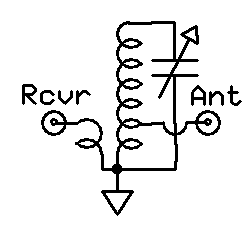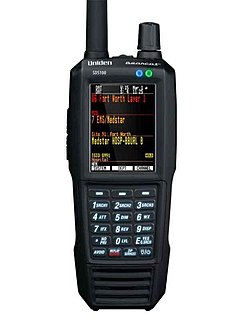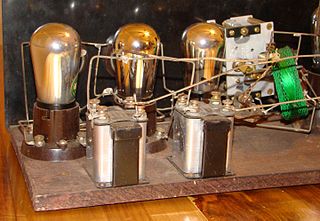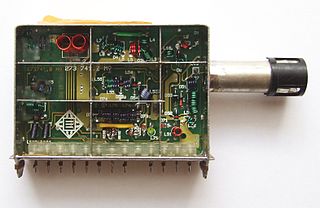 W
WIn radio communications, a radio receiver, also known as a receiver, a wireless or simply a radio, is an electronic device that receives radio waves and converts the information carried by them to a usable form. It is used with an antenna. The antenna intercepts radio waves and converts them to tiny alternating currents which are applied to the receiver, and the receiver extracts the desired information. The receiver uses electronic filters to separate the desired radio frequency signal from all the other signals picked up by the antenna, an electronic amplifier to increase the power of the signal for further processing, and finally recovers the desired information through demodulation.
 W
WA communications receiver is a type of radio receiver used as a component of a radio communication link. This is in contrast to a broadcast receiver which is used to receive radio broadcasts. A communication receiver receives parts of the radio spectrum not used for broadcasting, that includes amateur, military, aircraft, marine, and other bands. They are often used with a radio transmitter as part of a two-way radio link for shortwave radio or amateur radio communication, although they are also used for shortwave listening.
 W
WA crystal radio receiver, also called a crystal set, is a simple radio receiver, popular in the early days of radio. It uses only the power of the received radio signal to produce sound, needing no external power. It is named for its most important component, a crystal detector, originally made from a piece of crystalline mineral such as galena. This component is now called a diode.
 W
WThe Neutrodyne radio receiver, invented in 1922 by Louis Hazeltine, was a particular type of tuned radio frequency (TRF) receiver, in which the instability-causing inter-electrode capacitance of the triode RF tubes is cancelled out or "neutralized". to prevent parasitic oscillations which caused "squealing" or "howling" noises in the speakers of early radio sets. In most designs, a small extra winding on each of the RF amplifiers' tuned anode coils was used to generate a small antiphase signal, which could be adjusted by special variable trim capacitors to cancel out the stray signal coupled to the grid via plate-to-grid capacitance. The Neutrodyne circuit was popular in radio receivers until the 1930s, when it was superseded by the superheterodyne receiver.
 W
WIn the design of radio receivers, a noise blanker is a circuit intended to reduce the effect of certain kinds of radio noise on a received signal. It is often used on broadcast shortwave receivers or communications receivers and some types of two-way radio transceivers. The noise blanker is only effective on impulse-type noise such as from lightning or from automotive ignition systems, and cannot improve performance on wideband continuous background noise, or interfering signals on the same frequency. In cases where there are strong signals on frequencies near to the desired frequency, a noise blanker circuit may be ineffective and may reduce the quality of the received signal.
 W
WA preselector is a name for an electronic device that connects between a radio antenna and a radio receiver. The preselector is a band-pass filter that blocks troublesome out-of-tune frequencies from passing through from the antenna into the radio receiver that otherwise would be directly connected to the antenna.
 W
WRadar warning receiver (RWR) systems detect the radio emissions of radar systems. Their primary purpose is to issue a warning when a radar signal that might be a threat is detected. The warning can then be used, manually or automatically, to evade the detected threat. RWR systems can be installed in all kind of airborne, sea-based, and ground-based assets. This article is focused mainly on airborne military RWR systems; for commercial police RWR systems, see radar detector.
 W
WA scanner is a radio receiver that can automatically tune, or scan, two or more discrete frequencies, stopping when it finds a signal on one of them and then continuing to scan other frequencies when the initial transmission ceases.
 W
WThe radio spectrum scope was invented by Marcel Wallace and measures the magnitude of an input signal versus frequency within one or more radio bands - e.g. shortwave bands. A spectrum scope is normally a lot cheaper than a spectrum analyzer, because the aim is not high quality frequency resolution - nor high quality signal strength measurements.
 W
WA reflex radio receiver, occasionally called a reflectional receiver, is a radio receiver design in which the same amplifier is used to amplify the high-frequency radio signal (RF) and low-frequency audio (sound) signal (AF). It was first invented in 1914 by German scientists Wilhelm Schloemilch and Otto von Bronk, and rediscovered and extended to multiple tubes in 1917 by Marius Latour and William H. Priess. The radio signal from the antenna and tuned circuit passes through an amplifier, is demodulated in a detector which extracts the audio signal from the radio carrier, and the resulting audio signal passes again through the same amplifier for audio amplification before being applied to the earphone or loudspeaker. The reason for using the amplifier for "double duty" was to reduce the number of active devices, vacuum tubes or transistors, required in the circuit, to reduce the cost. The economical reflex circuit was used in inexpensive vacuum tube radios in the 1920s, and was revived again in simple portable tube radios in the 1930s.
 W
WA regenerative circuit is an amplifier circuit that employs positive feedback. Some of the output of the amplifying device is applied back to its input so as to add to the input signal, increasing the amplification. One example is the Schmitt trigger, but the most common use of the term is in RF amplifiers, and especially regenerative receivers, to greatly increase the gain of a single amplifier stage.
 W
WAn S meter is an indicator often provided on communications receivers, such as amateur radio receivers or shortwave broadcast receivers. The scale markings are derived from a system of reporting signal strength from S1 to S9 as part of the R-S-T system. The term S unit can be used to refer to the amount of signal strength required to move an S meter indication from one marking to the next.
 W
WA shortwave radio receiver is a radio receiver that can receive one or more shortwave bands, between 1.6 and 30 MHz. A shortwave radio receiver often receives other broadcast bands, such as FM radio, Longwave and Mediumwave. Shortwave radio receivers are often used by dedicated hobbyists called shortwave listeners.
 W
WA superheterodyne receiver, often shortened to superhet, is a type of radio receiver that uses frequency mixing to convert a received signal to a fixed intermediate frequency (IF) which can be more conveniently processed than the original carrier frequency. It was long believed to be invented by US engineer, Edwin Armstrong but after some controversy the patent is now credited to French radio engineer and radio manufacturer Lucien Lèvy. Virtually all modern radio receivers use the superheterodyne principle.
 W
WA table radio is a small, self-contained radio receiver used as an entertainment device. Most such receivers are limited to radio functions, though some have compact disc or audio cassette players and clock radio functions built in; some models also include shortwave or satellite radio functionality.
 W
WA transistor radio is a small portable radio receiver that uses transistor-based circuitry, which revolutionized the field of consumer electronics by introducing small but powerful, convenient hand-held devices. Following the invention of the transistor the first commercial transistor radio, the Regency TR-1, was released in 1954. The mass-market success of the smaller and cheaper Sony TR-63, released in 1957, led to the transistor radio becoming the most popular electronic communication device of the 1960s and 1970s. Transistor radios are still commonly used as car radios. Billions of transistor radios are estimated to have been sold worldwide between the 1950s and 2012.
 W
WA tuned radio frequency receiver is a type of radio receiver that is composed of one or more tuned radio frequency (RF) amplifier stages followed by a detector (demodulator) circuit to extract the audio signal and usually an audio frequency amplifier. This type of receiver was popular in the 1920s. Early examples could be tedious to operate because when tuning in a station each stage had to be individually adjusted to the station's frequency, but later models had ganged tuning, the tuning mechanisms of all stages being linked together, and operated by just one control knob. By the mid 1930s, it was replaced by the superheterodyne receiver patented by Edwin Armstrong.
 W
WA tuner is a subsystem that receives radio frequency (RF) transmissions and converts the selected carrier frequency and its associated bandwidth into a fixed frequency that is suitable for further processing, usually because a lower frequency is used on the output. Broadcast FM/AM transmissions usually feed this intermediate frequency (IF) directly into a demodulator that converts the radio signal into audio-frequency signals that can be fed into an amplifier to drive a loudspeaker.